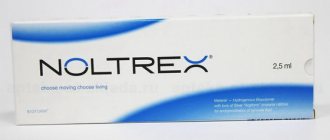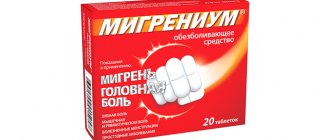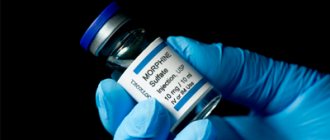Write a review
Reviews: 0
Manufacturers: Turk Hoechst
Active ingredients
- Halothane
Disease class
- Surgical practice
Clinical and pharmacological group
- Not indicated. See instructions
Pharmacological action
- Muscle relaxant
- Analgesic (non-narcotic)
- Analgesic (narcotic)
- Anesthesia
Pharmacological group
- Anesthetics
Pharmacological properties of the drug Halothane
Liquid volatile anesthetic, agent for inhalation anesthesia. Provides rapid induction of anesthesia with minimal symptoms characteristic of the excitement stage. Upon inhalation, it is absorbed in the alveoli and enters the systemic circulation. Penetrating through the BBB, it causes progressive reversible depression of the central nervous system, starting from higher parts (cerebral cortex) and ending with the vital centers of the medulla oblongata. Increases intracranial pressure. Blocks sympathetic ganglia, causes dilation of blood vessels in the skin and muscles. Increases the tone of the vagus nerve, causing bradycardia. It has a direct effect on the myocardium, reducing its contractility and cardiac output. Increases the sensitivity of the myocardium to catecholamines. Reduces systemic blood pressure. Halothane does not irritate the respiratory tract, has a dose-dependent bronchodilator effect, causes a reversible dose-dependent decrease in hepatic blood flow, glomerular filtration rate and diuresis; inhibits salivation, suppresses cough and gag reflexes. Weakens the contractility of the uterus. It does not have a significant effect on kidney function and the blood coagulation system, and does not lead to the development of acidosis. When used in combination with muscle relaxants, muscle relaxation is enhanced. The depressive effect on the central nervous system is directly proportional to the concentration of halothane in the blood. When inhaled, halothane is absorbed into the lungs. Halothane is poorly soluble in blood, so its concentration in arterial blood slowly reaches the level of concentration in the alveoli. Concentration levels in well-perfused tissues correspond to those in arterial blood. The concentration of halothane in the blood required for operations is 12 mg%; depression of the respiratory center is observed only at concentrations of 30–38 mg%. The minimum anesthetic concentration of halothane for adults is 0.77%, which corresponds to 15 mg% halothane in the blood. Adding 70% nitrous oxide to the anesthesia mixture can reduce the concentration of halothane to 0.3% (which corresponds to 6 mg% in the blood). Premedication with morphine can reduce its concentration to a small extent. The minimum anesthetic concentration is 1.08% in children under 6 months of age, 0.92% in children under 10 years of age, and 0.64% in persons over 70 years of age. Penetrates well through the placental barrier. The decrease in the concentration of halothane in the blood serum after stopping its supply is three-exponential and is due to distribution in three groups of tissues: well-vascularized (brain/heart/liver), skeletal muscles and adipose tissue. Approximately 80% of inhaled halothane is excreted unchanged through the lungs, the remainder - 20% - is metabolized in the liver through oxidation (under hypoxic conditions - through reduction reactions). The main metabolite is trifluoroacetic acid. The maximum concentration of the latter is observed 24 hours after anesthesia; metabolites are excreted in the urine within 1 week.
Aerosol for inhalation Halothane
Instructions for medical use of the drug
Description of pharmacological action
Blocks sympathetic ganglia (causes dilation of blood vessels in the skin and muscles); increases the tone of the vagus nerve (causing bradycardia); reduces intraocular pressure; has a direct effect on the myocardium, reducing systolic volume and contractility; increases the sensitivity of the myocardium to catecholamines; suppresses cough and gag reflexes; reduces the contractility of the myometrium; has a bronchodilator effect. Provides rapid induction of anesthesia without or with a minimal stage of excitation. The surgical stage of anesthesia is achieved in 4–6 minutes; awakening occurs quickly (within 5–15 minutes) with virtually no nausea or vomiting.
Indications for use
Inhalation anesthesia for major and minor surgical interventions in patients of any age.
Release form
liquid for inhalation; bottle (bottle) 50 ml; liquid for inhalation; bottle (bottle) 250 ml;
Pharmacodynamics
Blocks sympathetic ganglia (causes dilation of blood vessels in the skin and muscles); increases the tone of the vagus nerve (causing bradycardia); reduces intraocular pressure; has a direct effect on the myocardium, reducing systolic volume and contractility; increases the sensitivity of the myocardium to catecholamines; suppresses cough and gag reflexes; reduces the contractility of the myometrium; has a bronchodilator effect. Provides rapid induction of anesthesia without or with a minimal stage of excitation. The surgical stage of anesthesia is achieved in 4–6 minutes; awakening occurs quickly (within 5–15 minutes) with virtually no nausea or vomiting.
Contraindications for use
Hypersensitivity, acute liver damage, jaundice, malignant hyperthermia, pheochromocytoma, arrhythmia, myasthenia gravis, traumatic brain injury, increased intracranial pressure; the need for local use of adrenaline during surgery; gynecological operations in which uterine relaxation is contraindicated; I trimester of pregnancy; 3-month period after halothane anesthesia.
Side effects
Arrhythmia, bradycardia, arterial hypotension, respiratory depression, headache, tremor upon awakening, post-anesthesia chills, nausea, jaundice, hepatitis (with repeated administration), malignant hyperthermic crisis, post-anesthesia delirium.
Directions for use and doses
Maintaining the surgical stage of anesthesia - at a concentration of 0.5–2%; for induction of anesthesia, the concentration is gradually increased to 4%. The required concentration in the blood is 25%; minimum anesthetic concentration - 15% for adults; 1.08%, 0.92%, 0.64%, respectively, for infants, children under 10 years of age and patients over 70 years of age.
Overdose
Symptoms: severe bradycardia, arrhythmia, hypotension, hyperthermic crisis, respiratory depression. Treatment: mechanical ventilation with pure oxygen.
Interactions with other drugs
Enhances the effect of antidepolarizing muscle relaxants, antihypertensive drugs, digitalis preparations and m-cholinomimetics. Reduces tachycardia caused by trimethaphan. Increases the risk of liver damage with phenytoin. Aminoglycosides, lincomycin and polymyxins deepen the neuromuscular blockade (can cause apnea). Ketamine increases T1/2, methyldopa, nitrous oxide, morphine and phenothiazines increase the strength of anesthesia. The likelihood of developing malignant hyperthermia is increased by suxamethonium, and arrhythmias by xanthine.
Precautions for use
It should be borne in mind that the administration of adrenaline and other sympathomimetics increases the risk of developing arrhythmias. It is necessary to discontinue levodopa 6–8 hours before the start of anesthesia. Patients with chronic alcoholism require large doses for anesthesia.
Special instructions for use
Halothane should not be stored in evaporators. Before new use, the evaporator is thoroughly cleaned of residual halothane and its decomposition products.
Storage conditions
In a place protected from light, at a temperature not exceeding 25 °C.
Best before date
60 months
ATX classification:
N Nervous system
N01 Anesthetics
N01A Preparations for general anesthesia
N01AB Halogenated hydrocarbons
N01AB01 Halothane
Contraindications to the use of the drug Halothane
The period of childbirth, the first trimester of pregnancy, all cases of jaundice and hyperthermia after previous halothane anesthesia, a period of up to 3 months after previous halothane anesthesia, a history of malignant hyperthermia, liver disease, jaundice, increased intracranial pressure, the need for local use of adrenaline during surgery , hyperthyroidism, pheochromocytoma and other conditions in which the level of adrenaline in the blood is increased, indications of impaired liver function, jaundice, fever, leukocytosis, eosinophilia after the use of halogenated anesthetics.
Similar drugs:
- Sodium oxybate Solution for intravenous and intramuscular administration
- Propofol Lipuro Emulsion for infusion
- Calypsol Injection solution
- Ketalar Solution for intravenous and intramuscular administration
- Sodium oxybutyrate Substance-powder
- Ketanest Solution for intravenous and intramuscular administration
- Sodium oxybutyrate Solution for intravenous administration
- Propovan Emulsion for infusion
- Thiopental Lyophilisate for the preparation of solution for intravenous administration
- Propofol Kabi Emulsion for infusion
** The Drug Directory is intended for informational purposes only. For more complete information, please refer to the manufacturer's instructions. Do not self-medicate; Before starting to use the drug Halothane, you should consult a doctor. EUROLAB is not responsible for the consequences caused by the use of information posted on the portal. Any information on the site does not replace medical advice and cannot serve as a guarantee of the positive effect of the drug.
Are you interested in the drug Halothane? Do you want to know more detailed information or do you need a doctor's examination? Or do you need an inspection? You can make an appointment with a doctor - the Euro lab is always at your service! The best doctors will examine you, advise you, provide the necessary assistance and make a diagnosis. You can also call a doctor at home . Euro lab clinic is open for you around the clock.
** Attention! The information presented in this medication guide is intended for medical professionals and should not be used as a basis for self-medication. The description of the drug Halothane is provided for informational purposes and is not intended for prescribing treatment without the participation of a doctor. Patients need to consult a specialist!
If you are interested in any other drugs and medications, their descriptions and instructions for use, information about the composition and form of release, indications for use and side effects, methods of use, prices and reviews of drugs, or you have any other questions and suggestions - write to us, we will definitely try to help you.
Special instructions for the use of the drug Halothane
The occurrence of jaundice and hyperthermia after the use of halothane should be considered a contraindication to its further use. Repeated use of halothane should be avoided for 3 months after the previous anesthesia. Risk factors for hepatotoxicity include female gender, obesity and advanced age. Halothane should not be used in patients with hepatitis or liver cirrhosis. During halothane anesthesia, an increase in cerebral blood flow and/or an increase in intracranial pressure may be observed. These effects are usually more pronounced in the presence of intracranial tumors. To counteract these effects, moderate hyperventilation is used in neurosurgery. When using anesthesia, malignant hyperthermia syndrome may develop. During induction of anesthesia, a dose-dependent decrease in blood pressure may be observed; if necessary, methoxamine is administered intravenously (usually 5 mg). To eliminate bradycardia during anesthesia, premedication is carried out with intravenous administration of an anticholinergic drug or it is administered during maintenance anesthesia. It is recommended to ensure adequate room ventilation when using halothane. Halothane causes muscle relaxation, so it should be used with caution in patients with myasthenia gravis and/or when used concomitantly with aminoglycoside antibiotics.
Halothane
Halothane is hepatotoxic because it is converted in the liver into free radicals, the initiators of lipid peroxidation, and also forms metabolites (fluoroethanol) that covalently bind to biomacromolecules. The incidence of hepatitis is 1 case per 10,000 anesthesia in adult patients. In children, liver damage develops much less frequently.
Causes muscle relaxation, so it should be used with caution in patients with myasthenia gravis and/or when used concomitantly with aminoglycoside antibiotics.
During anesthesia, an increase in blood flow in the cerebral vessels and/or an increase in intracranial pressure may be observed. These effects are usually more pronounced in the presence of intracranial tumors. To counteract these effects, moderate hyperventilation is used in neurosurgery.
There is a risk of developing arrhythmias in children.
Use with caution when taking cardiac glycosides.
Treatment with MAO inhibitors should be discontinued 2 weeks before surgery.
It is necessary to discontinue levodopa 6-8 hours before the start of general anesthesia.
During gynecological operations, it should be taken into account that halothane can cause a decrease in myometrial tone and, as a result, an increased risk of bleeding.
Halothane relaxes the myometrium, so it is used in obstetric practice only in cases where relaxation of the uterus is indicated.
Patients with chronic alcoholism require large doses for anesthesia.
The possibility of developing malignant hyperthermia should be remembered if there is insufficient muscle relaxation at the beginning of anesthesia, as well as if fasciculations occur in response to the administration of ditilin (suxamethonium).
Monitoring the patient's condition under anesthesia is carried out by monitoring the pulse, blood pressure (measured manually or automatically, direct and indirect methods), continuous recording of the ECG, oxygen content in the blood (observing the color of the skin and mucous membranes, using a pulse oximeter or analysis blood), body temperature, pupil reaction, diuresis rate, blood tests for gases, electrolyte composition and acid-base status.
Cannot be stored in evaporators; Before new use, the evaporator must be cleaned of residual halothane and its decomposition products. Thymol (used for stabilization) does not evaporate, remains in the evaporator, coloring the solution yellowish, it is highly soluble, and is eliminated with ether.


